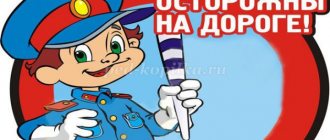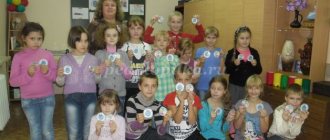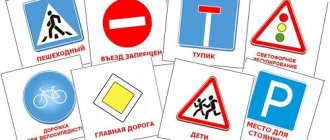Thematic conversation on traffic rules for grades 1-2. Abstract: Public transport
Thematic conversation on the topic: “Public transport” for grades 1-2
Author: Panfilova Nadezhda Pavlovna, primary school teacher MBOU “Razdolnenskaya school-gymnasium No. 2 named after L. Ryabika” Republic of Crimea
Traffic rules in elementary school. Thematic conversation for grades 1-2 “Public transport”
Description: the summary of the conversation will be of interest to primary school teachers, educators, additional education teachers, and caring parents. Introduce the rules of a pedestrian, broaden their horizons, give an idea of the dangers on the road - teach the child to live and act in real life. Purpose: familiarization with the rules of behavior in public transport and outside it. Objectives: .give an idea of the distinctive features of public transport, .expand knowledge about the rules of behavior on the road, .teach to be educated passengers in public transport, .instill responsibility for one’s life.
Progress of the conversation.
Motivation for cognitive activity. Conversation. The School of Traffic Sciences begins its lesson. -What is traffic rules? (Road rules.) -Why is it necessary to know the rules? -How do you understand the words “dangerous situation on the road”? -What could be the reason for such situations? Teacher. Traffic rules are a road map. Everyone should own one to prevent accidents. Updating basic knowledge. The game "Who is more faithful and faster." (Choose three inspectors. Students ask them different questions related to road safety. The game can be repeated several times.) 1. What parts does the street consist of? (Sidewalks and roadways, intersections) 2. Where can people walk? 3. Where can you cross the street? (At pedestrian crossings, which can be above-ground, underground, or overground.) 4. If you cross the roadway at a zebra crossing, where should you look first? (To the left, and in the middle - to the right.) 5. What does a pedestrian crossing indicate? (Traffic light, zebra crossing, road sign.) 6. At what traffic light can you cross the road? (On green.) (Awarding the best inspectors with prizes. Reporting the topic of the lesson. Today we will talk about transport on city streets. For the rapid movement of people over short and long distances, there is transport. -What is it called? Public transport - vehicles designed for transportation a large number of passengers and run on certain routes.
As soon as we buy a ticket for any type of public transport, we are passengers.
Work in groups. (There are 4 students in the group. - Let’s determine what public transport you took to get to school? To do this, each group collects a picture puzzle. (Attach the finished work to the board.) Guess the riddles. Doesn’t fly, doesn’t buzz, A beetle is running down the street. And two brilliant lights burn in the eyes of the beetle. (Car) (M. Doroshin.) A house goes down the street, Taking everyone to work. Not on thin chicken legs, But in rubber boots. (Bus.) (M. Doroshin.)
-Find something in common with the car. Establish differences with the car. (Big, small, many passengers.) (Does without wires, can travel where a trolleybus and tram cannot go. Buses and cars pollute the air with exhaust gases. This is very bad.) -Where do people use such public transport? Physical education We rode a horse, got to the corner, got into the car, poured gasoline. We drove by car and reached the river. Trrr! Stop! U-turn. We need to get on the plane. The plane is flying, the engine is humming: -U-U-U! Early in the morning outside the window - Knocking and ringing and chaos: Red houses walk along straight steel paths. (Tram.)
A tram is an electric rail public transport. It has an arc on the roof that moves along an electrical wire located at the top. The current flows through the arc to the tram engine, and through the engine to the wheels. -What are the differences with the bus? -Where do people use such transport? Guess what it is: Not a bus, not a tram, Doesn’t need gasoline, Even though the wheels are on rubber. (Trolleybus.)
Amazing carriage! Judge for yourself: The rails are in the air, and he holds them with his hands! (Trolleybus.) -How does a trolleybus differ from a tram? What common? -Where do people use such transport? -What should a driver of any public transport be like? (Attentive, experienced, knowledgeable, smart, healthy, polite.) Rules of conduct for passengers in public transport. -Tell me the rules of behavior at a bus stop, in transport? (Children's answers.) Don't linger in the aisle. .Pay the fare. .Don't litter, don't make noise, don't distract the will. .Do not lean out of vehicle windows. .Give your seat to older people and passengers with children. (Reading, repetition) -How should you get on public transport? (Through the back door.) -What about getting out of the transport? (Through the front door.) How to get around the TRAM? Remember! A stationary tram is bypassed from the FRONT!!!
When exiting the tram, you need to look to the right and, making sure it is safe, go to the sidewalk. Remember! A stationary bus and a trolleybus are bypassed from the BACK!
Role-playing game “We are passengers.” Goal: to practice the rules of behavior of passengers at a bus stop, in transport, when exiting a transport. Let's distribute the roles: driver, pedestrians, passengers, inspector. (Make transport out of chairs in advance.) -Boarding the bus. -Disembarkation of passengers and walk around the bus. (Trolleybus, tram.) Result of the conversation. — What happens if we violate the rule of bypassing traffic?
-Who will you tell about what you learned in class? The lesson at the School of Road Sciences is over.
We recommend watching:
Class hour on the topic: Traffic rules, grade 2 Texts with answers for conversations on traffic rules in grade 1 Extracurricular lesson on traffic rules on the topic “Question and answer on traffic rules,” grade 2 Crossword puzzle with questions and answers on traffic rules for schoolchildren 2 — 4 classes
Similar articles:
Traffic rules in elementary school
Traffic rules quiz for elementary school with answers
Sketch on traffic rules for students in grades 3 - 4
Drama on traffic rules for elementary school
Conversation on traffic rules in elementary school. Rules for pedestrians
Conversation “Rules of behavior on the road”
- I will start the sentence, and you will finish it, the sentence should begin with the words “and then.”
- First you need to wait for the green light at the traffic light, and then (.....
cross the road
.) - When crossing the road, you need to look to the left, and then (.....
to the right and start crossing the street.)
- Cross the road, only with an adult, holding on (
...by the hand.)
- You need to wait until the transport stops completely, and then (
.....start the transition.)
- Well done, guys
!
To start a little game we have to solve 1 riddle, listen.
Commanding the rod, he directs everyone, And he alone controls the entire crossroads. He is like a magician, a machine trainer, and his
…
(adjuster)
—
Right. Now let's imagine ourselves in the role of regulators.
Game "Traffic Controller"
Children have a red and a blue flag.
Words are named that denote different types of transport. Depending on which transport is named, children pronounce the words “pass”, “fly”, “swim”, and wave a blue flag at this time. If a word is called that is not related to transport, a red flag is raised and the word “stop” is pronounced. Physical exercise
Let's go, drive a car, (
imitation “turn the steering wheel”)
Press the pedal.
( right leg bent, unbent
) Turn on the gas, turn off the gas.
( lever towards oneself, away from oneself)
We look intently into the distance.
( palm to forehead)
The wipers clean off the drops - Right, left.
Purity! ( arms bent, in front of you, tilts to the right, left)
The wind ruffles your hair.
( fingers wiggle overhead)
We are drivers anywhere!
( raise their thumb up) Game “Bus” Teacher:
Now let’s imagine ourselves as passengers and we’ll all take a ride on the bus together.
- Who will we be sitting on the bus? (Passengers
) - How should passengers behave in transport and why?
( children's answers) Educator
: I will say where the bus is going, and you will answer how it moves and imitate the movements with your hands.
— The bus left the stop, what did it do? ... (drove off
).
— To another stop, what did you do? …. (drove up) .
- Then up a small hill, what did you do?
…. (moved in
).
- And he is a bridge with us, what did he do? ( moved).
- What did he do that made a big puddle?
... (drove around) .
- And he quietly approached our school, what did he do?
…. (drove up
).
-We got off the bus and walked to the boarding school. We are no longer passengers, but who are? (pedestrians).
3. Summary of the lesson:
Educator:
Let's remember and list the rules of behavior on the road and street. Children read out the answers. 1. People can only walk…..on the sidewalk. 2. You cannot play or run on the sidewalks. 3. You can cross the street only at ... the crossing, when the traffic light is green, holding an adult’s hand. If there is no traffic light near the pedestrian crossing, it doesn’t matter. In order to cross the street, you need to look to the left, if there are no cars, go to the dividing strip, and then look to the right, and if there are no cars, cross the street to the end. - Well done! Now I am sure that all of you will be well-mannered and disciplined pedestrians and will not get into an unpleasant situation. Have a safe trip! Thanks for the work!


